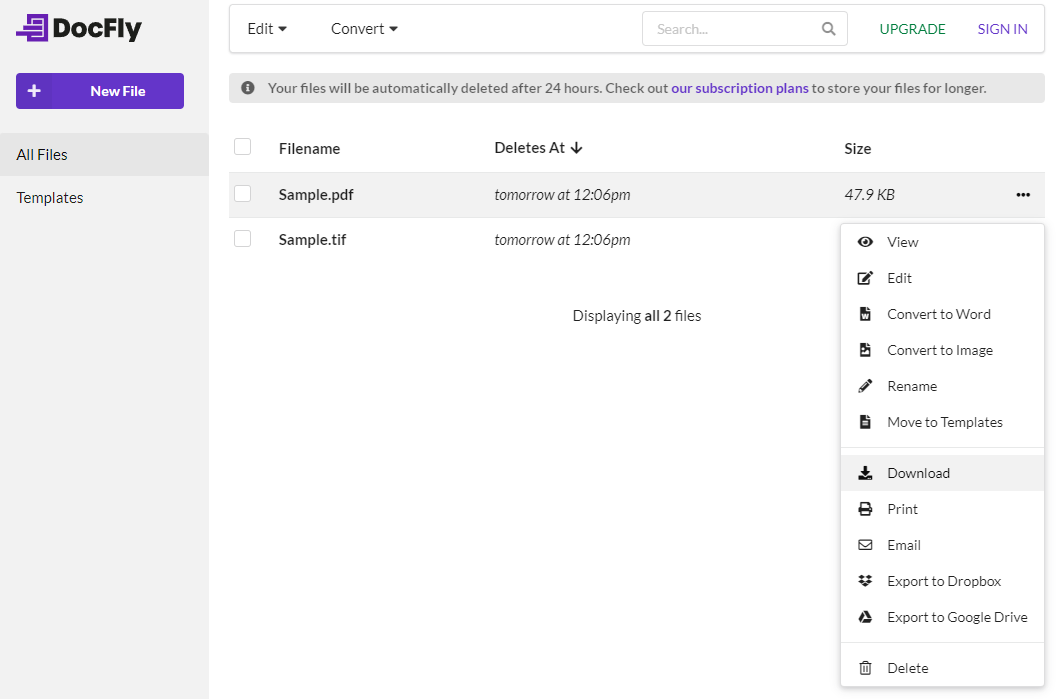How to Convert TIFF Images to PDF
Are you looking to convert your TIFF images into PDF files? You've come to the right place! In this guide, we'll walk you through the process of transforming your TIFF files into PDF format. But first, let's start with the basics: what exactly is a TIFF file, and why might you want to convert it to PDF? Read on to discover the benefits of converting TIFF format to PDF and how to do it quickly and easily. Let's dive in!
Table of Contents
What is a TIFF File Used for?
TIFF, which stands for Tagged Image File Format, is a raster graphics file format. This means that TIFF images that are composed of a grid of pixels and each pixel represents a single point of color. The image file format was developed in the 1980s and has since become a standard in various industries for storing high-quality images and documents. Here's why you might come across TIFF file types:
High-Quality Images
TIFF files are renowned for their ability to store images with exceptional quality. They support lossless compression, meaning that no image data is lost during compression. This makes TIFF the preferred format for storing scanned documents, photographs, and images where every detail matters, such as medical scans and architectural blueprints.
Wide Compatibility
TIFF files are compatible with a broad range of software applications and operating systems. This cross-platform compatibility ensures that your TIFF files can be opened and viewed on various devices without loss of quality.
Legal and Archival Documents
In legal and archival settings, TIFF is often chosen for preserving documents in their original, unaltered state. This format ensures that historical records and important documents remain intact and legible for future generations.
While TIFF is fantastic for preserving image quality and detail, it may not be the most user-friendly format for everyday use. This is where converting TIFF to PDF comes in handy. PDF (Portable Document Format) files are known for their accessibility, ease of use, and smaller file sizes.
Benefits of Converting TIFF to PDF
Converting your TIFF files to PDF offers a multitude of advantages, making your documents more accessible, manageable, and versatile. Here's why you should consider making the switch:
Universal Compatibility
PDFs are incredibly versatile and widely supported across various platforms and devices. This universality makes PDFs an excellent choice for ensuring that your documents are accessible to a broad audience.
Reduced File Size
TIFF files, known for their superb image quality, can be quite large, making them challenging to store. Converting them to PDF often results in reduced file sizes without compromising on image quality. This makes PDFs more manageable to share.
Text Searchability
PDFs can contain both images and text, and one of their standout features is the ability to make text within the document searchable.
Preservation of Formatting
When you convert a TIFF file to PDF, you retain the original formatting, fonts, and layout of the document. This ensures that your document looks the same on any device or platform, regardless of the software used to view it.
Ease of Printing
PDFs are designed for printing, and they ensure that your document will appear exactly as intended on paper.
Archiving and Long-Term Preservation
PDF/A, a subset of PDF, is specifically designed for long-term preservation of electronic documents. It ensures that your documents can be archived in a reliable format for years to come.
Converting TIFF to PDF Online with DocFly
DocFly is an online PDF editor that offers a range of conversion tools. Step-by-step instructions to convert TIFF to PDF using the online tool are provided below.
Step 1: Access the DocFly TIFF to PDF converter
Open your web browser and go to the page to convert TIFF to PDF on DocFly’s website.

Step 2: Upload Your TIFF image
Once on the DocFly website, click on “Click to upload your file.” You can either drag and drop your TIFF images into the indicated area or click on the button to upload the image you want to convert via the online converter. After uploading your document, DocFly will start processing the conversion immediately.

Step 3: Download Your Converted PDF
Once the conversion is complete, you can download your file to your device or export it to a cloud storage service like Google Cloud.

Converting TIFF to PDF Offline
In this section, we will explore how to convert TIFF images to PDF on both Windows and Mac computers using a variety of offline software options.
On Windows
Adobe Acrobat
Adobe Acrobat is a robust and widely used software suite that offers a comprehensive set of PDF tools for creating, editing, and managing PDF files. Converting TIFF images to PDF is a breeze with Adobe Acrobat:
- Launch Adobe Acrobat: Start Adobe Acrobat
- Access the Create PDF Option: From the 'Tools' menu, navigate to the 'Create PDF' option.
- Select Your TIFF File: Click on 'Select A File' within the PDF creation interface. A file dialog box will appear.
- Locate Your TIFF File: Browse to the location where your TIFF file is saved, and then select the TIFF file you want to convert to PDF.
- Create the PDF: After selecting your TIFF file, Adobe Acrobat will begin the PDF conversion process.
- Save Your PDF: Finally, click the save icon within Adobe Acrobat to save your newly created PDF to your desired location on your computer.
Print to PDF
Another simple way to convert images to PDF on Windows is by using the "Print to PDF" feature, which is built-in to Windows and does not require additional software.
- Open Your TIFF Image: Open the TIFF image in an image viewer on your computer.
- Print the Image: Now click on the 'File' menu, and select 'Print.' Look for an option that says "Microsoft Print to PDF" or something similar. This is the virtual PDF printer that allows you to convert the TIFF image to PDF.
- Print Settings: Before proceeding, you can adjust the print settings if needed.
- Print and Save: Now click the 'Print' button to start the conversion process. Windows will prompt you to choose a location to save the newly created PDF file.
On Mac
Preview
Preview is a versatile built-in application on Mac that goes beyond just viewing documents. You can also use it to convert TIFF files to PDFs. Here is how:
- Open the TIFF File: Locate the TIFF image file you want to convert and double-click it. This action should open the file in Preview.
- Access the Export Option: Click on the "File" menu at the top-left corner of the screen. In the dropdown menu, find and select "Export as PDF."
- Choose PDF Settings: A dialog box will appear. Here, you can choose the settings for your PDF file. You can adjust the file name, location, and quality.
- Save as PDF: Once you've configured your settings, click the "Save" button. Preview will then convert your TIFF file to a PDF and save it in the specified location.
Additional Tips for Converting TIFF Images to PDF
As you embark on your journey to convert TIFF images to PDF, here are some additional tips and tricks to help you streamline the process and achieve the best results:
Organize Your TIFF Files
Before conversion, take the time to organize your TIFF files. Rename them descriptively and arrange them in the order you want them to appear in the final PDF document.
Choose the Right Resolution
When converting images to PDF, consider the intended use of the PDF document. For on-screen viewing, a lower resolution (e.g., 72 dpi) is usually sufficient and results in smaller file sizes. However, for printing, especially high-quality printing, opt for a higher resolution (e.g., 300 dpi) to ensure the best image quality.
Compression Options
If file size is a concern, experiment with compress PDF options to strike a balance between file size and image quality. Lossless compression retains image quality, while lossy compression reduces file size but may lower image quality slightly.
File Backup
Always keep a backup of your original file. While the conversion process is generally safe, it is a good practice to ensure you have a copy of the original images in case you need them later.
With these tips in mind, you are well-equipped to efficiently convert your TIFF images to PDF. Harness the power of PDF to make your documents more accessible, shareable, and versatile.

Emily Shaw is the founder of DocFly. As a software developer, she built the service from scratch and is responsible for its operations and continued growth. Previously, she studied engineering at the University of Hong Kong and mathematics at the University of Manchester.
Loved what you just read? Share it!
Related posts you might enjoy
A Guide to Image File Formats (And When to Use Them)

Ultimate Guide: Documents that Should Always be in PDF

